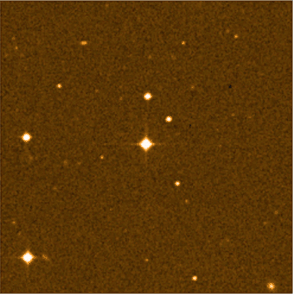Astronomers have spotted for the first time the fingerprint of uranium-238 in an ancient star - and have used it to make the most reliable guess yet of the age of the universe. Roger Cayrel of the Observatoire de Paris-Meudon, France, and colleagues have used a kind of 'stellar carbon dating' to estimate the age of the star - and therefore the minimum age of the universe. The new estimate makes the universe 12.5 billion years old - give or take 3 billion years (R Cayrel et al 2001 Nature 409 691).

Cayrel and colleagues used the Very Large Telescope at the European Southern Observatory in Chile to measure the spectra of a very old star – known as CS31082-001 – near the edge of the Milky Way. Astronomers know that the star formed in the very early universe because it contains so little metal. Metals were scarce at this stage in the evolution of the universe because very few supernova, which create metals, had yet exploded. Indeed, the traces of uranium-238 in the star’s atmosphere could have come from just one supernova. The uranium-238 absorption lines are relatively easy to detect in metal-poor stars because they are not obscured by the strong absorption lines of other metals.
Astronomers know approximately how much of each element was originally present in the star and they can compare this with the abundances they see in the spectra today. They can then calculate – using the half-lives of the radioactive elements – how long ago the star was born. This is known as cosmochronometry.
Cayrel’s team has now used this technique to date the universe from the new uranium-238 signal from CS31082-001. The half-life of uranium-238 is only 4.5 billion years, so it has had time to decay to about an eighth of its original abundance. Taking into account uncertainties about the initial abundance of elements, Cayrel’s and co-workers have obtained an estimate of 12.5 billion – or 12.5 x 109 – years old, plus or minus just 3 billion years. This is three times more accurate than the previous best estimate, which was based on absorption lines of thorium-232. Thorium-232 has a half-life of 14 billion years – similar to our current best guess of the age of the universe, and this means it can only have decayed by about half. Accounting for our assumptions about the initial composition of stars, thorium-232 can only provide a rough estimate – 4 to 5 billion years each way – of the age of the universe.
Cayrel and colleagues hope that they will soon be able to date the universe even more precisely by measuring the relative line intensities more accurately. The possible range of ages for the universe will also narrow as we learn more about the ratios in which elements are created in stars. ‘We are already planning new surveys to discover other metal-poor stars in which we can measure the abundances of uranium and thorium,’ said Timothy Beers, a member of the research team based at Michigan State University. ‘In the next few years, we expect to find perhaps 10 or 20 of these stars.’
Other methods of dating the universe – such as measuring how quickly galaxies recede from us – are less reliable because they are based on untested assumptions about the evolution of the universe.



